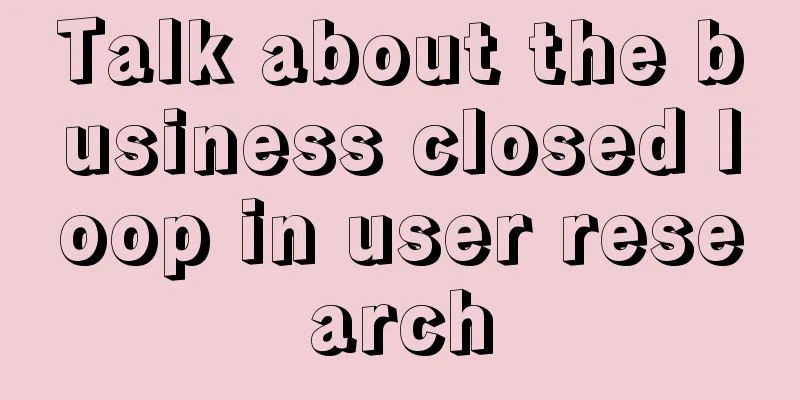Talk about the business closed loop in user research

Values such as "everything starts from user needs" and "always put users first" have become "politically correct" in all companies that provide products and services today. User researchers spare no effort to explore user needs and use a magnifying glass to diagnose user experience in order to serve the user, their God. However, after doing user research for many years, I found that many business demand parties do not seem to be satisfied with the data results based on user needs provided by user researchers. Many of them shouted:
So, you finally understand that there is nothing wrong with "user orientation", but they didn't tell you that "user orientation" is not above profit orientation, cost orientation, competition orientation, and efficiency orientation, but that it must be combined. Only when considering profit, cost orientation, competition, efficiency, etc. can "user orientation" be satisfied. The business closed loop I want to talk about today is actually the considerations of profit, cost, competition, efficiency, etc. in addition to "user orientation". Without these considerations, user research is like a castle in the air or a tree without roots. Logically speaking, in the current era of highly specialized division of labor, the business closed loop should be mainly led or responsible by the business demand side, and user research should only be responsible for providing the required user data. It is said that there are similar practices abroad. User researchers only provide data results reports of user surveys, without giving conclusions and opinions, and try to remain objective and neutral. The business side makes decisions based on the user data results. In China, as far as I know, it is basically difficult. User researchers who only provide data results will be considered to lack insight. In other words, research consultation is the default capability requirement for user researchers. This situation is caused, on the one hand, by capacity issues. In many cases, the business demanders themselves have no idea on how to make good products and services, so naturally they cannot put forward good requirements to user researchers, nor can they derive decisions directly from data results. On the other hand, it is due to problems with the cooperation mechanism between domestic user research personnel and business demanders. The existing mainstream user research project process basically involves the business demanders only at the beginning and the end (demand communication and results reporting). The two core links of research design and data result interpretation are basically the responsibility of user researchers to ensure objectivity and neutrality. Research consulting essentially re-examines user research from the perspective of a closed-loop business model. It mainly involves using closed-loop business thinking to guide research design and using closed-loop business thinking to interpret data and output insights. 1. Use business closed-loop thinking to drive research and designSuppose you are in the automotive industry, and your business has a goal to develop the next generation of vehicle systems (in-vehicle infotainment systems). As a user researcher, how can you provide support? Generally speaking, user researchers will combine quantitative and qualitative research methods, starting from the current status of usage behavior and experience evaluation, combined with the preferences and expectations of car computer usage behavior, to explore users' needs and pain points and classify them. They will also further prioritize various needs based on models or tools such as importance and ease of satisfaction, and further segment the population to analyze the characteristics and differences in the needs of different groups of people. For example, the user's car system needs can be divided into five aspects according to functions, and through research, the specific needs and pain points in the five aspects can be deeply explored. It is also possible to dig deeper into the needs by combining user usage scenarios: scenarios that require interaction in the car include entertainment scenarios, maintenance scenarios, rest scenarios, attendance scenarios, picking up children scenarios, couple dating scenarios, in-car gatherings scenarios, vehicle rental scenarios, long-distance travel scenarios, autonomous driving scenarios, shared rental scenarios, outside-car interaction scenarios, smart home interconnection scenarios, etc. There is nothing wrong with this, but from the perspective of a closed business loop, it is far from enough. After completing this step, we also need to add a competitive perspective, that is, to study the current status and layout of competitors in these functional and scenario requirements. For example, through competitive analysis, it was found that Tesla's car system is already in a leading position in smart travel, and has first-mover advantages in long-distance travel and autonomous driving scenarios; Huawei's Hongmeng car system is already in a leading position in smart interconnection, and has advantages in entertainment, smart home interconnection and other scenarios. So from the perspective of competing for users' minds, we must avoid these directions and create our own differentiation. Competitive analysis is not the end. If you only get to this step, you cannot implement it because you still need to consider the feasibility of technical capabilities. Therefore, the research also needs to include a technical evaluation section. Technical evaluation starts from the perspective of meeting consumer needs. Solving these needs requires combining technologies, and which specific related technologies can help meet consumer needs. For example, behind the smart travel function is artificial intelligence (AI) technology, which is difficult to achieve in the short term and is a long-term track; behind the smart interconnection function is the system ecology, which is also difficult to achieve in the short term and is also a long-term track; audio and video entertainment, learning and office, and smart scenario functions belong to the software application level and are expected to break through and lead the industry in the short term, and can create a differentiated mindset. Therefore, the ultimate research framework based on the business closed loop should be a triangle consisting of user needs, market competition, and technology evaluation. 2. Use business closed-loop thinking to interpret data and output insightsAfter doing research for many years, I have come to feel more and more that the core value of user researchers lies in their understanding of the business and their ability to interpret data and output opinions based on their understanding of the business. Every page of data we present in the final report should have clear viewpoints, business implications and applicability. Otherwise, we should think about whether the data is really valuable and whether it is necessary to present it. Every conclusion in our report should be the result of comprehensive consideration of user research, market competition, and the feasibility of internal resources/technology/capabilities, rather than just taking what the user says and giving them what they want. Taking the above project of vehicle system planning as an example, suppose the survey users want to add a function to the vehicle system. The survey results are as follows: (Public information, JDPower & Yiche: 2018 Chinese Consumer Car Machine (In-Vehicle Infotainment System) Usage Experience and Preference Survey Report) So can we suggest that colleagues in the product development department add 360-degree cameras inside and outside the car in the future? Obviously not. Simply drawing conclusions based on the survey data would make us look a bit stupid, lacking in-depth thinking, and also lacking in business implementation. The correct approach is to first combine the vehicle system requirements/driver rankings to clarify whether this functional requirement is a baseline requirement or a differentiated requirement. If it is conducive to improving the baseline requirement experience, it can be considered. (Public information, JDPower & Yiche: 2018 Chinese Consumer Car Machine (In-Vehicle Infotainment System) Usage Experience and Preference Survey Report) From a demand-driven perspective, the 360-degree camera inside and outside the car is one of the baseline requirements for assisted driving/navigation. It can improve driving safety, facilitate parking, etc., and the improvement in user experience is quite obvious. Secondly, we also need to look at it from a competitive perspective. Do competing products have this function? If not, we need to be cautious and do a more comprehensive and detailed analysis. If so, what are the market performance and user word-of-mouth reviews, and how much impact will it have on purchasing motivation? Furthermore, from a technical perspective, can this product function be realized in the short term? This function involves hardware cameras and software systems. The cameras can be purchased from outside in the short term, but system adaptation requires research and development time. Finally, it is also based on the overall strategy. If the product positioning focuses on audio-visual entertainment and intelligent scene functions, and creates differentiation in entertainment and rest scenes, then this function should obviously not be launched, and Internet TV playback (similar to Xiaomi Box and Apple TV) can be considered instead; if the target group is senior middle-class people, then it is necessary to analyze the user structure of those who have demand for 360-degree cameras inside and outside the car, and what percentage of senior middle-class people are in the group. If most of them are senior middle-class people, that is, the strategically positioned group needs this function, then it can be seriously considered, otherwise it should not be launched. Therefore, it is not easy for us to output clear and practical insights. Thinking about many of my previous research projects, most of them stopped at the stage of sketching research data. I did not go further to do more exploration and analysis, and I hastily drew conclusions, which is very regrettable. Author: Liu Peilong; WeChat public account: User Research Stories (ID: gh_cdf8873fdd23) |
<<: Is the social recommendation of video account a false proposition?
>>: The most popular words on B station this year are two words
Recommend
The total number of online views exceeded 3 billion, and "scare yourself" swept the screen, controlling abstract netizens
In this era of information explosion and content b...
Data Analyst, how to find a job for yourself
On the one hand, data analysis can solve the pain ...
Establishing a data indicator system from scratch
Internet people deal with data in many scenarios a...
Recruiting "Internet celebrities" and creating IP, is JD.com's ambition for live streaming no longer hidden?
JD.com is recruiting influencers through live stre...
Mixue Ice City has become a prominent brand of new tea drinks
There is no circle that the Snow King cannot squee...
How to file a complaint if you are cheated by a cross-border e-commerce company? How to recover the money?
When many friends open a store on the cross-border...
Dong Jie made "slow live broadcast" popular
The author of this article introduces several typi...
How long does it take to deliver from the United States to China? What can't be delivered by international express?
Now many friends buy overseas products. When you b...
How to operate cross-border e-commerce during the epidemic? How to do it well?
With the rapid development of cross-border e-comme...
1000 original articles completed! Here's a 3000-word summary for you!
The author shares his creative ideas for writing 1...
How to settle cash on delivery payment on Lazada? FAQ
Lazada is also a kind of cross-border e-commerce p...
Can high school students engage in cross-border e-commerce? How to do it?
In today's Internet era, cross-border e-commer...
How can user operations accurately issue coupons by building an uplift model?
Issuing coupons is a precision marketing process. ...
This cooking variety show has a good copywriting
This article starts from a cooking variety show &q...
618 is still inseparable from Li Jiaqi
This year's 618 e-commerce promotion is not on...









